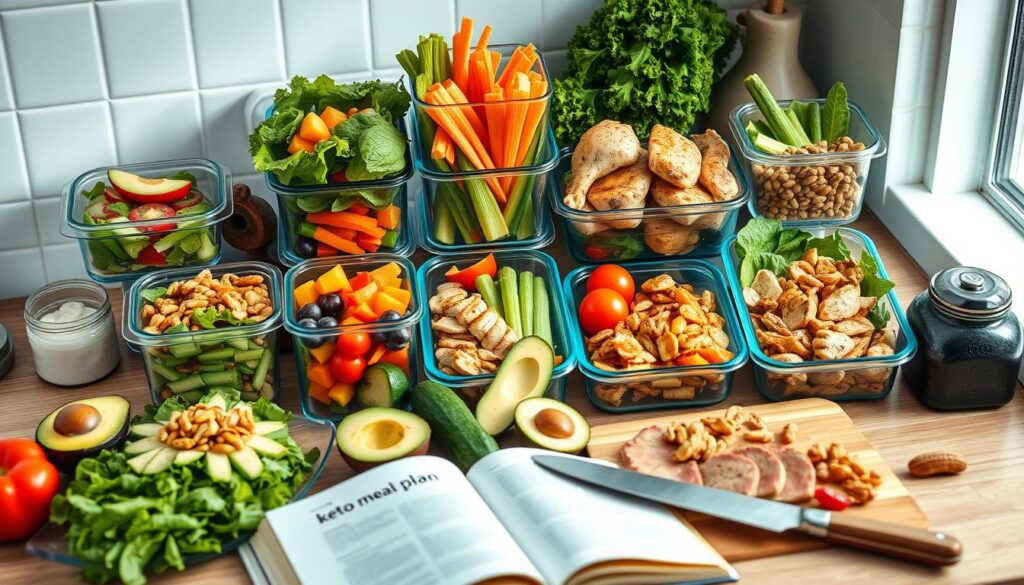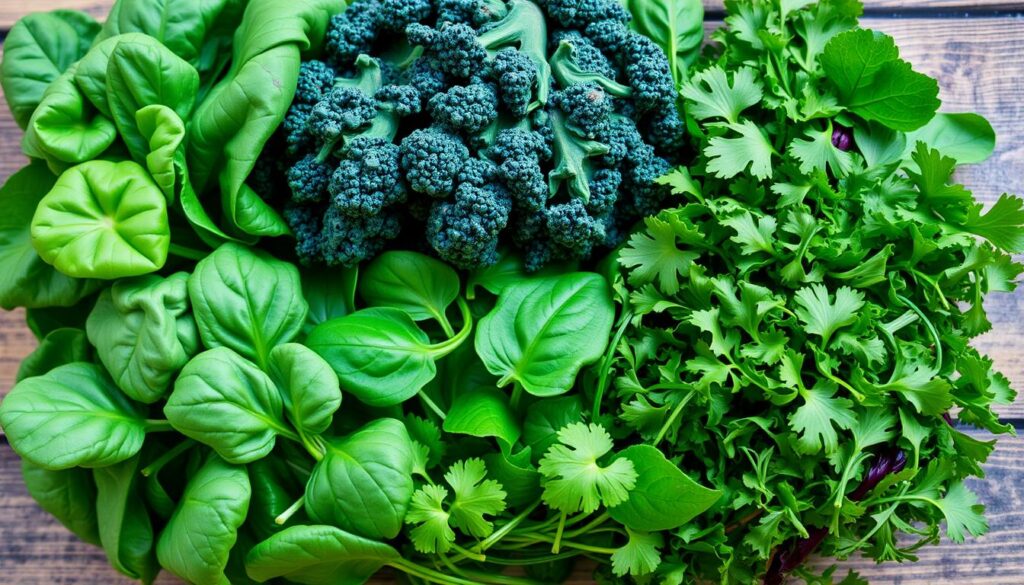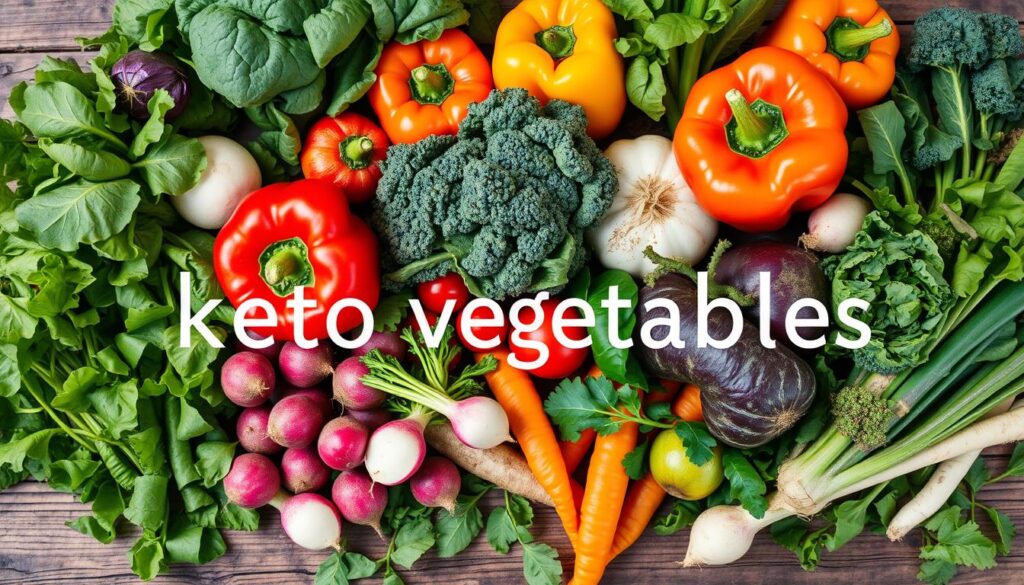Are you on a ketogenic diet and finding it hard to pick the right veggies? Don’t worry, we’ve got you covered! This article will show you the best keto vegetables. They’ll help you stay in ketosis and keep you healthy.

Finding keto-friendly produce can seem tough, but it’s easier than you think. With the right info, you can add many low-carb veggies to your meals. But, what makes a vegetable truly keto-friendly? And how do you pick the best keto-friendly produce? Let’s find out together.
Understanding the Basics of a Ketogenic Diet and Vegetable Choices
To get the most from your ketogenic diet, knowing about vegetables is key. This diet is low in carbs and high in fat. It makes your body burn fat instead of sugar. In this state, ketogenic diet vegetables are crucial for staying in ketosis.
What Makes a Vegetable Keto-Friendly?
The main thing to look at is a vegetable’s net carb content. Net carbs are total carbs minus fiber. Fiber doesn’t raise blood sugar. So, veggies with low net carbs are best for staying in ketosis.
Net Carbs vs. Total Carbs in Vegetables
It’s important to know the difference between net carbs and total carbs when picking carb-conscious greens and other healthy keto foods. Total carbs include all carbs, including fiber. Net carbs only count the carbs that raise blood sugar.
The Role of Fiber in Keto Vegetables
Fiber is a big deal when choosing keto-friendly vegetables. Even though it’s a carb, it doesn’t raise blood sugar. It helps with digestion and keeps you full longer.
Top Keto Vegetables for Optimal Ketosis
To get into ketosis, where your body uses fat for energy, you need the right foods. It’s key to add fiber-rich vegetables with low carbs to your diet. Here are some top nutrient-dense keto options for better ketosis.
- Broccoli: This low-net-carb produce is full of fiber, vitamins, and minerals. Enjoy it raw, roasted, or in keto dishes.
- Cauliflower: It’s versatile and low in net carbs. Use it as a rice or pizza crust substitute in your keto kitchen.
- Zucchini: A fiber-rich vegetable that can be spiralized, grilled, or baked. It’s great for low-carb noodles or bread.
- Spinach: Rich in nutrients and low in net carbs, spinach is a keto superstar. Add it to salads, omelets, or sautéed dishes.
- Asparagus: This low-net-carb produce is full of fiber and vitamins. It’s perfect for keto meals and side dishes.
Adding these fiber-rich vegetables and other nutrient-dense keto options to your diet helps your body stay in ketosis. This leads to weight loss, more energy, and better health.
Green Leafy Vegetables: The Foundation of Keto Success
Green leafy vegetables are key in a ketogenic diet. They help your body get into ketosis. They also offer many health benefits that boost your overall well-being.
Best Leafy Greens for Keto
Here are the top leafy greens for a keto diet:
- Spinach
- Kale
- Romaine lettuce
- Arugula
- Swiss chard
- Collard greens
Preparation Methods and Storage Tips
To get the most from your leafy greens, handle them carefully. Choose gentle cooking like sautéing or steaming. Or, enjoy them raw in salads. Store them fresh by wrapping in a damp paper towel and refrigerating.
Nutritional Benefits of Leafy Greens
Leafy greens are packed with vitamins, minerals, and antioxidants. They’re full of vitamin A, C, K, folate, and magnesium. These nutrients are vital for your body on a keto diet. Plus, their fiber helps with digestion and bowel movements.
“Adding a variety of leafy greens to your keto meals is great for your body. It helps with weight loss too.”

Above-Ground Vegetables vs. Root Vegetables on Keto
On a keto-friendly diet, knowing the difference between above-ground and root vegetables is key. Both can fit into a keto meal plan, but they affect ketosis differently.
Above-ground veggies like leafy greens, broccoli, and cauliflower have fewer net carbs and more fiber. They’re better for a keto diet because you can eat more without breaking ketosis. They’re packed with nutrients and don’t raise blood sugar much.
Root veggies, like potatoes, carrots, and beets, have more net carbs. They’re good for vitamins and minerals but can upset a keto diet if eaten too much. It’s important to eat them in moderation.
| Above-Ground Vegetables | Root Vegetables |
|---|---|
| Leafy greens (spinach, kale, arugula)BroccoliCauliflowerZucchiniCucumber | PotatoesCarrotsBeetsTurnipsRadishes |
Knowing the difference helps you choose the right foods for a keto diet. Eating a variety of keto-friendly vegetables and fruits is key for a balanced diet.

High-Fiber Keto Vegetables for Digestive Health
Keeping your gut healthy is key on a ketogenic diet. Fiber-rich veggies are essential. They help your digestive system and overall health.
Fiber-Rich Options for Gut Health
Some top fiber-rich keto veggies are:
- Broccoli
- Cauliflower
- Spinach
- Kale
- Brussels sprouts
- Avocado
- Zucchini
These veggies are great for a keto diet. They also offer many important nutrients for health.
Balancing Fiber and Net Carbs
On a keto diet, watch your net carbs. Net carbs are total carbs minus fiber. Fiber-rich veggies have low net carbs, making them good keto choices. But, balance fiber and net carbs to stay in ketosis.
Daily Fiber Requirements on Keto
Adults need 25-30 grams of fiber daily. On keto, meeting this is crucial for digestive health. Adding fiber-rich veggies to your meals helps meet this need without leaving keto.
Common Mistakes When Selecting Keto Vegetables
Starting a keto diet is exciting and rewarding. But, it’s key to pick the right veggies. Knowing which ones to avoid helps keep you in ketosis and on track with your health goals.
Many people forget that some veggies have too many carbs. Leafy greens and veggies from above the ground are usually okay. But, root veggies and starchy ones can throw off your keto plan. It’s important to know which keto vegetables to avoid for good meal planning.
Steer Clear of These Keto Vegetables
- Potatoes
- Carrots
- Corn
- Peas
- Beets
- Parsnips
These foods to avoid on keto have too many carbs. They can pull you out of ketosis, even if they’re good for you. Stick to low-carb veggies like leafy greens, cruciferous ones, and some fruits to stay on keto.
| Vegetable | Net Carbs per Serving |
|---|---|
| Spinach | 0.4g |
| Broccoli | 2.4g |
| Cauliflower | 2g |
| Zucchini | 1.1g |
| Asparagus | 2.1g |
Choosing low-carb, nutrient-rich veggies and avoiding common mistakes keeps your keto diet on track. Try different keto-friendly veggies to keep your meals interesting and your body burning fat.
Creative Ways to Prepare Your Keto Vegetables
Keeping your keto diet exciting and satisfying is key. This means making the most of your keto-friendly produce. We’ll share ideas on cooking methods and simple recipes to enhance your veggies’ flavor and nutrition.
Cooking Methods That Preserve Nutrients
The way you cook your keto veggies matters a lot. Choose gentle methods like steaming, roasting, or sautéing. These help keep the veggies’ nutrients and vitamins intact. Avoid overcooking to prevent losing these important nutrients and to keep the texture good.
Simple Keto Vegetable Recipes
Simple keto veggie dishes can be incredibly tasty. Try roasted Brussels sprouts with garlic and lemon, or sautéed zucchini noodles with pesto. You can also grill portobello mushroom caps with creamy spinach and Parmesan inside. These recipes highlight the veggies’ natural flavors while keeping carbs low.
Seasoning and Flavor Enhancement Tips
Seasonings and flavor enhancers can make your keto veggies stand out. Use herbs like rosemary, thyme, and oregano, or add grated Parmesan or fresh lemon juice. For creaminess, try full-fat sour cream or garlic-infused olive oil. These small touches can take your keto veggie dishes to the next level.
FAQ
What makes a vegetable keto-friendly?
A vegetable is keto-friendly if it has low net carbs and is rich in nutrients. These veggies are high in fiber and low in starch. They also don’t raise blood sugar levels much.
What is the difference between net carbs and total carbs in vegetables?
Total carbs include all carbs in a veggie, like digestible carbs and fiber. Net carbs are what your body absorbs, after subtracting fiber from total carbs. Focusing on net carbs helps keep you in ketosis.
Why is fiber important in keto-friendly vegetables?
Fiber is key in a keto diet. It’s a carb that your body doesn’t digest or absorb, so it doesn’t affect blood sugar. Fiber-rich veggies support digestion, make you feel full, and meet your daily fiber needs.
What are the best leafy green vegetables for a keto diet?
Top leafy greens for a keto diet include spinach, kale, arugula, Swiss chard, and romaine lettuce. These greens are low in carbs, high in fiber, and full of vitamins and minerals.
How do above-ground vegetables differ from root vegetables on a keto diet?
Above-ground veggies like leafy greens, broccoli, and zucchini are better for a keto diet. They have fewer carbs than root veggies like potatoes, carrots, and beets. Root veggies are higher in starch and carbs, making it harder to stay in ketosis.
What are some common mistakes to avoid when selecting keto-friendly vegetables?
Avoid choosing high-carb veggies like corn, peas, and potatoes. Don’t ignore net carbs and make sure to include a variety of low-carb, nutrient-rich greens and veggies. Always check nutrition labels to stay within your carb limit.
What are some creative ways to prepare keto-friendly vegetables?
You can roast veggies with healthy fats, sauté them in butter or olive oil, spiralize them, or blend them into soups and sauces. Trying different cooking methods and seasonings makes keto veggies more tasty and fun.
